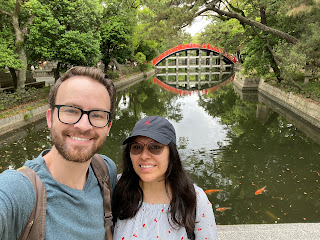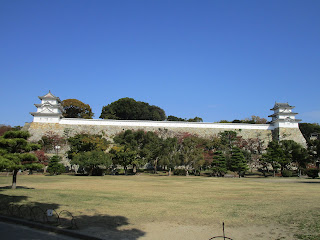Kyushu Trip Part I Nagasaki
 |
| Day 2 - Nagasaki Peace Statue |
Day 1 Nagasaki
This trip was the longest one we've done so far—a total of nine days! And our first time visiting Kyushu. We had to take three trains to get there and it all took about four hours. We arrived around 1 p.m. and were quite hungry. There are many restaurants in the station but if you're there during lunch hour many of them will have a bit of a wait since seating is limited. For the evening, we saw Dejima. It is an artificial island from the 17th century previously used for trading purposes, first with the Portuguese and then with the Dutch. The city has worked on slowly restoring it to how it was when the Dutch lived there.
At dinnertime we ate chanpon, and saraudon, both Nagasaki specialties.
Day 2 Nagasaki
During World War II, on August 9th, 1945, Nagasaki was the second city to be hit with an atomic bomb. We went to the Peace Park. The first things we saw were the Peace Statue and peace water fountain. In the museum, I was surprised to learn about some people having the misfortune to be present at both bombings!
These are Words from the Sculptor next to the Peace Statue (pictured at the top of the page):
“After experiencing that nightmarish war,
that blood-curdling carnage,
that unendurable horror,
Who could walk away without praying for peace?
This statue was created as a signpost in the
struggle for global harmony.
Standing ten meters tall,
it conveys the profundity of knowledge and
the beauty of health and virility.
The right hand points to the atomic bomb,
the left hand points to peace,
and the face prays deeply for the victims of war.
Transcending the barriers of race
and evoking the qualities of Buddha and God,
it is a symbol of the greatest determination
ever known in the history of Nagasaki
and the highest hope of all mankind.”
— Seibo Kitamura (Spring 1955)

From that area we walked over to the Urakami Cathedral. About 1.5% of Japanese people are Christian. It’s a small percentage but Nagasaki is one of the places where there are various hidden Christian places. The church began to be built in 1895 when the ban against Christianity was lifted and a French priest, Bernard Petitjean, had discovered that many of the Japanese people living there were ‘hidden Christians.’ The church was completed in 1925, but ended up being destroyed by the bomb in 1945. They rebuilt it in 1959 on the same site where it stood originally.
Nagasaki Atomic Bomb Hypocenter
From the church we walked to the Hypocenter Park. There is a black stone that marks the hypocenter, where the atomic bomb detonated about 500 meters above the ground destroying ⅓ of the city and killing/injuring about 150,000 people. Near the Hypocenter Park is the Nagasaki Atomic Bomb Museum and the National Peace Memorial Hall for the Atomic Bomb Victims. There is also a part of the ground near the hypocenter that is preserved as how it was after the bombing.
Day 3 Nagasaki
Our second church visit was to Oura Catholic Church. It was built in 1864 in dedication to the 26 Martyrs of Japan, who were killed in 1597. Next to the church is the Christian museum talking about the history of Christianity in Japan, pictures are prohibited and it is mostly in Japanese.Next stop was the Glover Garden. It has several Western-style buildings from previous foreign residents. The main one is the Glover House, the oldest wooden Western-style house in Japan, owned by Scottish merchant Thomas Glover. I was surprised to learn that some of the buildings in the garden were actually relocated from other parts of the city. After walking around the garden we built up an appetite and started looking for a place to eat lunch. We found a small place that had Nagasaki torukoraisu, a dish with pilaf rice, pork cutlet with demi-glace sauce, and spaghetti.

We started walking back towards our hotel with a few sightseeing items along the way. The first one was the Confucius Shrine, which we only briefly saw from outside due to time constraints, then the Dutch Slope. The Dutch Slope is a stone paved slope where a lot of Dutch lived in 1859 since Nagasaki was a trade port. It was starting to sprinkle and we knew more rain was forecast for later that night so we hurried on our way to Chinatown in hopes to find an early dinner. Unfortunately, while we were there it began to pour and all the restaurants we still closed and would open for dinner until later. Luckily, there were some stands selling street food and we tried kakuni manju, pork belly buns. It was delicious! Since it was still raining the stand worker said we could eat it inside the souvenir shop.
Day 4 Nagasaki
Our last day in Nagasaki before heading to Fukuoka we visited Sofoku-ji Temple. It was built in 1629 by Chinese residents and you can see that it was designed with a Chinese architectural style. It has been destroyed by multiple fires with the last reconstruction being in 1849.
Megane-bashi, or Spectacle Bridge, is a stone bridge from 1634. There was a flood in 1982 that damaged the bridge, but some of the stones were able to be recovered and repaired. It wasn’t super crowded when we were there but it is a popular spot for people. There was also a famous ice cream stand near by that Blake had seen on the YouTube channel "Abroad in Japan," it happened to open while we were there and we were able to try it!
The bridge was not too far from our hotel, which we had to go back to pick up our luggage before visiting the 26 Martyrs of Japan Memorial on the way to the train station. Catholic missions in Japan at first had support from the shogunate and Imperial government, partly to try and reduce the influence of Buddhist monks. But by the late 16th century, they were concerned about foreign influence in the country and Christianity was banned.

The 26 martyrs were four Spaniards, one Mexican, one Portuguese from India, 3 Japanese Jesuits, and 17 other Japanese Christians including 3 altar boys. Toyotomi Hideyoshi issued orders for their arrest in January 1597. On February 5, 1597 they were crucified on a hill in Nagasaki city but even before that they had been subjected to torture and paraded through the villages.
With luggage in hand we went to the station to buy bullet train tickets to Fukuoka and it was busy! We bought our tickets at a machine for the hour and half trip and departed Nagasaki shortly afterwards.
With luggage in hand we went to the station to buy bullet train tickets to Fukuoka and it was busy! We bought our tickets at a machine for the hour and half trip and departed Nagasaki shortly afterwards.















Comments
Post a Comment